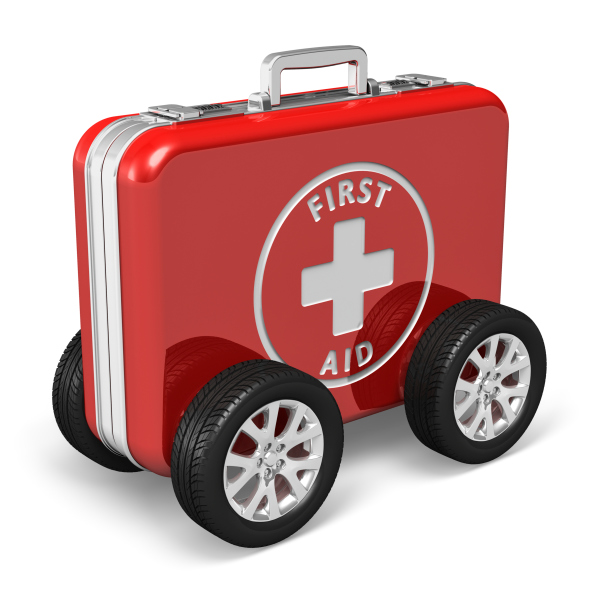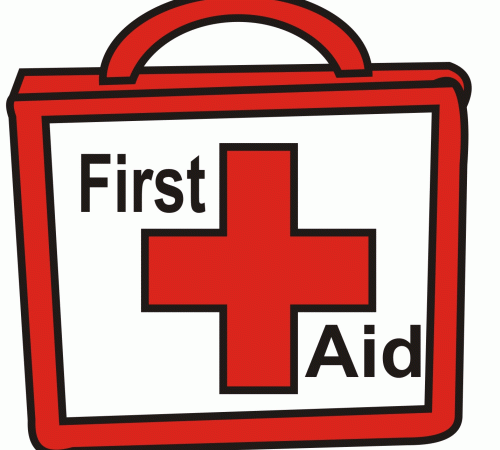RVers, especially road wandering or boondocking types, are often far from first aid treatment options in the event of accidents, burns, cuts and abrasions, sickness, etc. If you encounter the need for medical treatment, do you have the necessary elements of medical treatment in your on-board first aid kit?
There are many pre-packed First Aid kits on the market, with some specifically designed for travel and available at RV parts stores like camping World. Check out the options and compare to the following list. You can always add items to a basic kit. And you will likely add your own personal favorites to the kit as well. And don’t forget to replace items as they are used.
Here are some tips on what to stock in your all-purpose first aid kit, and I hope you will never have to use any more of it than is needed to treat minor scrapes or cuts and an occasional bee sting. But you can also be confident that you will have what is necessary to provide “first aid” when needed, what will be adequate until you can get to professional medical help.
First Aid manual—the better the manual the better you will be able to handle treatment of emergencies. Look for one that includes step-by-step pictures and clear, easy to understand, directions.
Ace bandages – roll (self-stick athletic)
Adhesive tape
Alcohol wipes
Antacids
Antibacterial soap
Antibiotic cream
Antibiotic soap
Anti-diahreal medication
Antihistamine (Benadryl) – Use to counteract effects from insect stings
Anti-itch cream
Anti-nausea, motion sickness pills
Antiseptic, antiseptic wipes, hydrogen peroxide
Bandage pads (assorted sizes)
Bandage squares (for cleaning)
Band-Aids (assorted sizes)
Bee sting kit (including suction pump to extract venom)
Burn ointment and/or spray
Butterfly bandages closures (holds sides of cuts together)
Compresses
Cotton swabs
Eye drops, eye wash
Gauze pads and wraps
Heat/cold packs
Insect repellent
Latex gloves
Mirror (hand, small)
Moleskin (for blisters)
Pain relievers like aspirin, ibuprofen, acetaminophen, and naproxin
Poison ivy/oak cream
Q-tips
Safety pins
Sanitizer (hand)
Scissors
Sunburn lotion
Thermometer
Tweezers (regular and for pulling ticks)
You can find Bob Difley’s RVing ebooks on Amazon Kindle.




Bob Difley
Thanks, Ralph, for that good advice.
Anonymous
Good morning, Bob Difley;
First; thank you for a comprehensive listing of the contents of a first aid kit suggested for use with an RV.
Second; while you did list a good first aid manual as the very first item for the suggestions for the RV first aid kit, there is one more thing about that first aid manual that really should be mentioned: I would add the recommendation that people sit down with a cup of coffee or tea or something similar, and READ that first aid manual, BEFORE it is actually needed.
Trying to look up in the book what is the suggested procedure to follow during an emergency is not a very effective way to do it, and it delays providing the needed care. Having already read the book and perhaps remembering where in the book to find that information if required will be a real help when an incident requiring that information really does come up.
Taking a course in first aid will also be a great help if that need does happen, and at some point it will. Having the time to actually practice some of the procedures and wrapping a bandage around various parts of the human body does help when you have someone in front of you with their hand over a wound and they are leaking blood that is dripping off their fingers while you are getting out the bandaging materials.
First aid classes and CPR classes are available from the American National Red Cross, the American Heart Association, many local fire departments, community colleges and schools, and other providers of that first aid information and training.
Ralph Javins
Latté Land, Washington